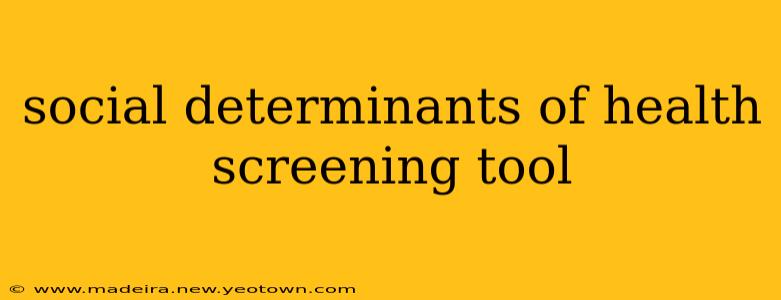The journey to better health isn't just about checkups and prescriptions; it's deeply intertwined with our social circumstances. Social determinants of health (SDOH) encompass the conditions in which we live, learn, work, and play – factors that significantly impact our well-being. Understanding these influences is crucial for effective healthcare, and that's where social determinants of health screening tools come in. This guide explores various tools, their applications, and considerations for their effective use.
Imagine Sarah, a 45-year-old single mother working two minimum-wage jobs. She's constantly stressed about making ends meet, struggles to afford healthy food, and lives in a neighborhood with limited access to parks and safe recreational spaces. Sarah's health risks extend far beyond her genetic predisposition; her SDOH are significantly impacting her well-being. This is where a robust SDOH screening tool can make a real difference.
What are Social Determinants of Health Screening Tools?
Social determinants of health screening tools are questionnaires or assessments designed to identify individuals and communities facing challenges related to SDOH. These tools are not diagnostic; instead, they act as a vital first step in understanding an individual's or community's circumstances and connecting them with appropriate resources. They cover a broad range of factors, including:
- Economic Stability: Employment, income, food security, housing stability.
- Education Access and Quality: Literacy, early childhood education and development, high school graduation, enrollment in higher education.
- Health Care Access and Quality: Health coverage, access to care, provider quality.
- Neighborhood and Built Environment: Access to healthy food, quality of housing, crime and violence, environmental conditions.
- Social and Community Context: Social support, civic participation, discrimination, incarceration.
Types of Social Determinants of Health Screening Tools
Various screening tools cater to different needs and contexts. Some are brief, focusing on key indicators, while others are more comprehensive, delving into specific SDOH areas. The choice of tool depends on the specific goals, the target population, and the available resources. For example:
- Brief screening tools: These are often incorporated into routine clinical visits, focusing on identifying individuals at high risk. They are quick to administer and require minimal training.
- Comprehensive assessments: These are more in-depth and may be used for research purposes or in community health settings. They require more time and may need specialized training.
- Population-level assessments: These tools collect data on SDOH at the community level, helping to identify areas needing targeted interventions.
How are Social Determinants of Health Screening Tools Used?
The application of these tools is diverse:
- In clinical settings: Healthcare providers can use them to identify patients facing SDOH challenges and connect them with appropriate resources, such as food banks, housing assistance, or social workers.
- In community health programs: Public health professionals utilize them to assess the needs of specific populations and tailor interventions.
- In research studies: Researchers employ these tools to investigate the impact of SDOH on health outcomes.
What are the Benefits of Using Social Determinants of Health Screening Tools?
The advantages of incorporating SDOH screening are substantial:
- Improved patient care: By identifying challenges early, clinicians can provide more holistic care and address underlying social factors contributing to health disparities.
- Reduced health disparities: Targeted interventions based on SDOH assessments can help address systemic inequalities and improve health outcomes for vulnerable populations.
- Better resource allocation: Data from screening tools can help allocate resources more effectively, directing them to areas and populations with the greatest need.
- Enhanced patient-provider communication: Screening prompts conversations about social factors influencing health, fostering stronger patient-provider relationships.
What are some examples of Social Determinants of Health Screening Tools?
There isn't a single "best" tool, as the optimal choice depends on context. Several organizations develop and offer tools; some are publicly available, while others require licensing or training. It's important to research and select a tool appropriate for your setting and purpose. Some examples include tools from the CDC, the American Academy of Pediatrics, and various healthcare systems and community organizations.
How Effective are Social Determinants of Health Screening Tools?
The effectiveness of SDOH screening tools depends on several factors, including:
- The quality of the tool itself: A well-designed tool should be valid, reliable, and culturally appropriate.
- The implementation process: Effective implementation requires proper training, integration into workflows, and access to appropriate resources.
- The availability of community resources: The tool's usefulness is limited if there are no resources available to address the identified needs.
What are the Challenges in Using Social Determinants of Health Screening Tools?
While beneficial, there are challenges associated with the implementation and use of these tools:
- Time constraints: Integrating screening into busy clinical workflows can be challenging.
- Data privacy concerns: Gathering sensitive information requires careful consideration of privacy and confidentiality.
- Resource limitations: Connecting patients to resources requires coordination with community organizations, which may be constrained by funding or capacity.
- Lack of standardized tools and data collection methods: This limits the ability to compare results across different settings and populations.
Conclusion
Social determinants of health screening tools are powerful instruments for improving population health and reducing health disparities. By understanding and addressing the social factors that impact well-being, we can move towards a more equitable and just healthcare system. Careful selection, implementation, and ongoing evaluation are critical for ensuring the effectiveness of these tools and maximizing their impact on individuals and communities.

